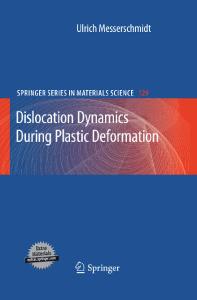Single Crystal Deformation Experiments for Validation of Dislocation Dynamics Simulations
- PDF / 272,175 Bytes
- 12 Pages / 612 x 792 pts (letter) Page_size
- 2 Downloads / 408 Views
W2.9.1
Single Crystal Deformation Experiments for Validation of Dislocation Dynamics Simulations David H. Lassila, Mary M. LeBlanc, and Moono Rhee Lawrence Livermore National Laboratory, P.O. Box 808 L-113, Livermore, CA 94551-0808. ABSTRACT A new experimental apparatus has been developed for performing compression deformation experiments on high-purity Mo single crystals. These experiments provide data that can validate 3-D dislocation dynamics (DD) simulations. The experiments are performed under conditions that allow unconstrained deformation; thus, a relatively uniform state of axial stress is maintained during deformation. In the following sections, we describe the new experimental apparatus and our results from experiments performed at ambient temperature at a strain rate of s–1. Validation criteria based on the Mo experiments may include comparing the stress-strain response using 3-D strain information, the predicted slip-system yield, and work-hardening behavior. INTRODUCTION In the past 10 years, there have been numerous developments in the area of 3-D, discrete DD simulation capabilities [1–5]. These computer codes can now simulate the stress-strain response (yield and work-hardening) and accompanying dislocation structure evolution of both facecentered cubic (fcc) and body-centered cubic (bcc) single crystals. At this time, the computer codes can simulate the deformation response to strains up to 1%. The codes are generally more efficient in terms of computational speed when simulating high strain-rate deformation (e.g., strain rates of s–1 or greater). In the case of bcc metals, a large body of experimental data exists [6,7]. Many interesting properties of bcc metals—such as their high strain-rate and temperature dependence of the yield strength, and their wavy glide at high temperatures—have been studied extensively. However, relatively few studies have reported the type of detailed information that is needed to rigorously validate DD simulations at the small strains that are of interest (i.e., on the order of 0.1 to 1.0%). To effectively validate these simulations, the axial stress-strain response and as much information as possible about any slip activity during the deformation must be recorded. When a single crystal deforms, the various slip-system activities typically result in irregular shape changes. In deformation experiments, these irregular shape changes can lead to nonuniformities in stress states in the crystal and/or a nonuniform strain field. Because of this possibility, researchers must take special care to understand both the crystal’s stress state and shape change during deformation if they wish to collect the information needed to validate 3-D DD-simulation results. In this work, we describe an experimental technique that was developed to minimize the nonuniformities in stress state that can occur during the deformation of single crystals. This technique was specifically developed to enable the validation of 3-D, discrete DD simulations. When using this technique, a deformation experim
Data Loading...











